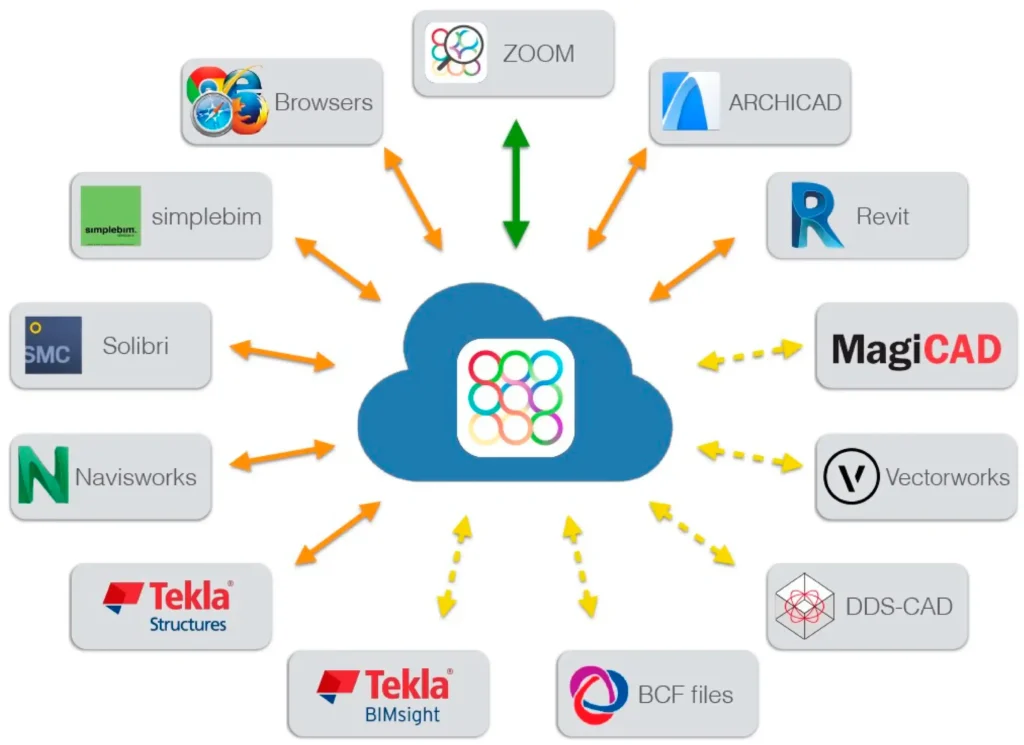Building Information Modeling (BIM) has been a foundation of the current construction, engineering, and design. In contrast with 2D drawings, BIM offers a dynamic and rich data-driven environment in which architects, engineers, contractors, and owners can visualize, study, and organize projects during their lifecycle. BIM can greatly help the construction value chain, including minimizing errors and rework, supporting smarter collaboration, and other legitimate benefits.
Nevertheless, BIM has not been adopted without difficulties. The barriers that are common to firms of the size of companies include problems of data interoperability, lack of collaboration and communication, and high cost of software and implementation. These barriers may be left uncurbed, which may result in impediments to adoption and the failure of teams to achieve the full potential of BIM.
This blog will explore each of these challenges in detail and offer viable, workable solutions to them that construction professionals can adopt to simplify their workflow, enhance their performance, and their BIM adoption to maximize their ROI.
Understanding BIM in Context
When considering the issues of BIM, one must keep in mind that BIM is not merely a software solution but a team-based approach and process. Fundamentally, BIM is the development of 3D models with intelligence, which can be used as a source of truth by all stakeholders of the project process, beginning at the earliest design stages, through to managing the facilities.
BIM is a system that, unlike the traditional CAD system, the geometry, metadata, and scheduling and cost data are all integrated in a single platform. Such integration is what makes it possible to identify clashes even before construction is started and make material usage more efficient and project delivery easier. However, it is the same integration that complicates BIM: all the fields such as architectural, structural, mechanical, electrical, and plumbing, have to provide the data that can be perfectly combined.
The benefits of BIM are diminished when the workflow fails or when the tools fail to communicate with each other. The general challenges are most usually associated with the interoperability of data between software platforms, the coordination of multidisciplinary teams, and software investment costs. When approached in a strategic manner, these areas allow organizations to extract the real worth of BIM.

Challenge 1: Data Interoperability Issues
Data interoperability is a characteristic of the various BIM software systems and stakeholders to exchange, interpret, and utilize model data without any form of inaccuracy. Theoretically, though, interoperability is a huge roadblock. Architects can operate with Revit, and structural engineers can work with Tekla, whereas the contractors can choose Navisworks or ArchiCAD. All platforms have proprietary file formats that frequently do not cross-systematically.
Such a failure to have a seamless exchange may result in inconsistency of models, loss or duplication of work. As an example, the exportation of an IFC file in a given program and the importation of the said file to another may lead to the loss of attributes, disfigurement of geometry, or the displacement of objects.
Consequences of Poor Interoperability
- Project Delays: Teams spend additional time cleaning up, reformatting, or remodeling data.
- Data Misinterpretation: Lost parameters or corrupted geometry can lead to design errors.
- Increased Costs: Extra labor and software add-ons raise project expenses.
- Stakeholder Frustration: Misaligned data reduces confidence in the model as the “single source of truth.”
Actionable Solutions
- Adopt Open Standards
- Use IFC (Industry Foundation Classes) and COBie (Construction Operations Building Information Exchange) to promote compatibility across platforms.
- Push for standardized deliverables in project contracts to ensure all parties adhere to consistent formats.
- Leverage Cloud-Based Platforms
- Common data environments (CDEs) like Autodesk Construction Cloud, Trimble Connect, or Bentley ProjectWise allow stakeholders to collaborate on a shared model in real time, reducing the need for constant file transfers.
- Invest in Staff Training
- Provide training on how to properly export, import, and manage models across platforms.
- Teach teams to use interoperability plug-ins and tools that automate file conversions.
- Standardize Processes Early
- Develop a BIM Execution Plan (BEP) at the beginning of the project that defines naming conventions, file formats, and data exchange protocols.
- Establish quality checks at each stage of model sharing to prevent issues from snowballing.
Paying attention to interoperability, companies will be able to significantly decrease the amount of wasted labor, eliminate expensive mistakes, and ensure the smooth flow of information at every phase of the project.
Challenge 2: Collaboration and Communication Gaps
Data interoperability is a characteristic of the various BIM software systems and stakeholders to exchange, interpret, and utilize model data without any form of inaccuracy. Theoretically, though, interoperability is a huge roadblock. Architects can operate with Revit and structural engineers can work with Tekla, whereas the contractors can choose Navisworks or ArchiCAD. All platforms have proprietary file formats that frequently do not cross-systematically.
Such a failure to have a seamless exchange may result in inconsistency of models, loss or duplication of work. As an example, the exportation of an IFC file in a given program and the importation of the said file to another may lead to the loss of attributes, disfigurement of geometry, or the displacement of objects.
Common Pain Points
- Lack of a single source of truth: different versions of models exist across teams.
- Version control issues: multiple stakeholders editing files without proper synchronization.
- Misaligned goals: architects focus on design aesthetics while contractors prioritize buildability.
- Delayed communication: stakeholders learning about design changes late in the process.
Actionable Solutions
- Centralized Model Management
- Adopt a common data environment (CDE) such as Autodesk BIM 360, Trimble Connect, or Bentley ProjectWise to maintain one authoritative model.
- Ensure everyone works from the same data set in real time.
- Clear Communication Protocols
- Establish regular coordination meetings (weekly or bi-weekly).
- Run clash detection sessions early and often using tools like Navisworks or Solibri.
- Adopt Real-Time Collaboration Tools
- Cloud-based solutions allow simultaneous model editing, reducing time lost in file transfers.
- Tools like Revizto or BIMcollab improve issue tracking and model-based communication.
- Foster Cultural Change
- Collaboration is not just technical; it requires trust, transparency, and accountability.
- Train teams to view BIM as a collaborative process rather than “software ownership” within departments.
By creating a collaborative culture supported by technology and clear communication, organizations can reduce friction, minimize costly mistakes, and ensure project success.
Challenge 3: High Software and Implementation Costs
While BIM delivers long-term value, the upfront investment can be daunting, especially for small and mid-sized firms. Costs include:
- Software licenses and subscriptions.
- High-performance hardware requirements.
- Continuous staff training and upskilling.
- Ongoing upgrades and maintenance fees.
For smaller firms, these expenses can create hesitation to fully adopt BIM, leaving them at risk of falling behind larger competitors who can absorb the costs.

Impact on Businesses
- Limited BIM adoption among smaller firms and subcontractors.
- Inequality in competitiveness, with larger firms better positioned to bid on BIM-mandated projects.
- Longer ROI cycles make it harder for firms to justify the investment upfront.
Actionable Solutions
- Start Small with Pilot Projects
- Implement BIM gradually instead of across all projects at once.
- Use pilot projects to refine workflows and measure ROI before scaling.
- Explore Affordable or Open-Source Alternatives
- Tools like FreeCAD, BlenderBIM, or BricsCAD offer budget-friendly options.
- Hybrid workflows can integrate low-cost solutions with enterprise platforms.
- Leverage SaaS and Subscription Models
- Instead of purchasing expensive perpetual licenses, opt for pay-as-you-go cloud-based subscriptions.
- Scale licenses up or down based on project needs.
- Seek Government or Industry Support
- Many governments and professional associations provide incentives, subsidies, or training grants to encourage BIM adoption.
- Industry consortia may offer shared resources at lower costs.
- Measure and Communicate ROI
- Track tangible savings from reduced errors, clash detection, and improved efficiency.
- Use data-driven ROI to justify continued investment to stakeholders.
The approach of addressing BIM as a long-term investment and not an expense can enable firms to handle costs strategically and remain competitive in a changing construction environment.
Best Practices for Overcoming BIM Challenges
Although it is crucial to address data challenges, collaboration issues, and cost issues separately, a comprehensive solution will guarantee overall success. The companies that practice uniform best practices in their BIM strategy are much better placed to realize the potential of the strategy.
Key Best Practices:
- Develop a BIM Execution Plan (BEP)
- Create a detailed roadmap at the start of each project.
- Define naming conventions, data exchange formats, responsibilities, and workflows.
- Standardize Workflows and Templates
- Build repeatable processes across projects.
- Reduce confusion by using company-wide BIM standards for documentation, modeling, and data management.
- Promote Continuous Training and Upskilling
- Regularly train staff on new tools, interoperability workflows, and collaboration techniques.
- Encourage certifications to keep teams updated on global best practices.
- Embrace Cloud-Based Ecosystems
- Cloud platforms reduce interoperability friction and centralize collaboration.
- Enable remote teams to access models anytime, anywhere.
- Foster a Culture of Innovation
- Encourage staff to see BIM as more than software, it’s about improving efficiency and delivering better outcomes.
- Recognize and reward innovative use of BIM in projects.
- Monitor Progress with KPIs
- Track BIM adoption with metrics like clash reduction rates, cost savings, and project timelines.
- Use this data to refine future workflows and improve ROI.
A strong BIM strategy will be achieved by entrenching these best practices into daily operations thus minimizing risks, enhancing collaboration, and maximizing project efficiency.
Conclusion
BIM has taken centre stage in the present-day construction sector, and it has provided the construction industry with robust tools to automate the working process, minimise errors, and enhance teamwork. However, interoperability of data, absence of collaboration, and software cost are all obstacles to implementation.
These obstacles are manageable. Firms can increase the value of BIM by embedding open standards, investing in cloud-based collaboration platforms, acting small to manage costs effectively, and promoting a culture of collaboration. Such best practices as the development of a BIM Execution Plan, workflow standardization, and ongoing training also guarantee long-term success.
In the end, those organizations that adopt such solutions will not only eliminate the current pain points but also be able to prosper even in the future where BIM, AI, and digital construction ecosystems are the standard. BIM is not necessarily software, but it is a mindset and a process that, once put in place in a strategic way, will change how we design, construct, and even manage the built environment.





